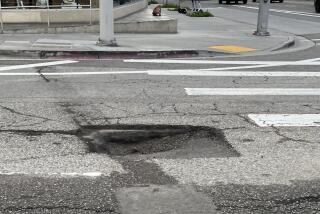Editorial: Getting more realistic on L.A. pension returns
- Share via
In the last year, all three of Los Angeles’ public employee pension funds have recalculated their too-rosy estimates of how much they will earn in the years ahead. Those lowered earning forecasts may cost the city in the short term — if it has to deposit more money into the funds now rather than counting on the market to earn the money later. But over the long term, the more conservative assumptions will help ensure that there is enough money to cover the city’s pension promises.
The three funds, which provide pension benefits and retirement healthcare for police officers, firefighters, civilian workers and Department of Water and Power employees, will now assume an average return of 7.5%, instead of the current 7.75%, based on projections that investments will earn less. That may not sound like much of a change, but the decisions could cost the city as much as $50 million in the next year alone.
It’s good to see pension fund managers taking a more fiscally conservative approach. But Mayor Eric Garcetti and the fund managers should continue to ask whether the city is being careful enough. If Los Angeles learned anything from the last few years, when the city teetered on the edge of bankruptcy, it’s that a little financial discipline in good years can prevent a lot of pain in the bad ones.
When the recession hit and the value of the public pension funds’ investments plummeted, L.A. — like many cities and states across the nation — found itself in a difficult situation. It owed hundreds of millions of extra dollars to ensure that the funds could meet obligations made to workers and retirees even as tax revenues were dropping precipitously. The city had to lay off workers, reduce library hours, stop trimming trees and cut other programs while pension payments quadrupled over the decade ending in 2013.
In reality, the problems of public pension funds existed long before the market crashed; generous pay and benefits were promised without setting aside enough money to cover the long-term obligations. Politicians thought they could afford to be munificent, in part because of the overly optimistic assumption that the economy would keep growing and that pension fund investment returns would cover the expense. Instead, when the recession hit, the city had to take money from public services to cover the gap between anticipated earnings and actual earnings. The recession made clear the risks that come with overly optimistic projections.
Now, as the economy and the city’s budget situation improve, city officials have the opportunity to set the funds on a path toward long-term financial stability, a path that protects against future recessions. Garcetti, who has promised to make fiscal responsibility a cornerstone of his administration, should put together a panel of apolitical, independent financial experts who can assess the city’s pension systems and recommend changes to ensure that retirement benefits are fully funded, in good and bad times alike.
Are Los Angeles’ 7.5% assumptions still too optimistic? (An audit last year of the city’s civilian pension system recommended lowering projections to 7.25%. And by comparison, Detroit will emerge from bankruptcy with a court-approved 6.75% rate of return assumption on its pension plans.)
Are the decisions being made today on pay, pensions and healthcare benefits based on realistic assumptions of how much those promises will cost tomorrow?
Will Los Angeles be able to cover its pension obligations in the next financial downturn?
More conservative assumptions — or more realistic ones, as some would argue — may make it harder for the city to give pay raises, hire more workers or restore much-needed services in the near term. And politicians are famously unwilling to accept short-term pain for long-term gain. That’s why in 2013 California’s 130 public pension systems, including L.A.’s, had $198 billion in unfunded liabilities — the gap between what workers and retirees are owed and how much money the funds have to pay them — up from $6.3 billion in 2003. Los Angeles has a chance to avoid repeating the mistakes of the past by preparing now for a more stable, secure financial future.
Follow the Opinion section on Twitter @latimesopinion
More to Read
A cure for the common opinion
Get thought-provoking perspectives with our weekly newsletter.
You may occasionally receive promotional content from the Los Angeles Times.









